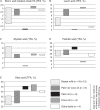Lipid Quality in Infant Nutrition: Current Knowledge and Future Opportunities
- PMID: 25883056
- PMCID: PMC4927316
- DOI: 10.1097/MPG.0000000000000818
Lipid Quality in Infant Nutrition: Current Knowledge and Future Opportunities
Abstract
Dietary lipids are key for infants to not only meet their high energy needs but also fulfill numerous metabolic and physiological functions critical to their growth, development, and health. The lipid composition of breast milk varies during lactation and according to the mother's diet, whereas the lipid composition of infant formulae varies according to the blend of different fat sources. This report compares the compositions of lipids in breast milk and infant formulae, and highlights the roles of dietary lipids in term and preterm infants and their potential biological and health effects. The major differences between breast milk and formulae lie in a variety of saturated fatty acids (such as palmitic acid, including its structural position) and unsaturated fatty acids (including arachidonic acid and docosahexaenoic acid), cholesterol, and complex lipids. The functional outcomes of these differences during infancy and for later child and adult life are still largely unknown, and some of them are discussed, but there is consensus that opportunities exist for improvements in the qualitative lipid supply to infants through the mother's diet or infant formulae. Furthermore, research is required in several areas, including the needs of term and preterm infants for long-chain polyunsaturated fatty acids, the sites of action and clinical effects of lipid mediators on immunity and inflammation, the role of lipids on metabolic, neurological, and immunological outcomes, and the mechanisms by which lipids act on short- and long-term health.
Conflict of interest statement
The authors report no conflicts of interest.
Figures




References
-
- WHO. Global Strategy for Infant and Young Child Feeding. Geneva: WHO; 2003. - PubMed
-
- Koletzko B, Shamir R, Ashwell M. Quality and safety aspects of infant nutrition. Ann Nutr Metab 2012; 60:179–184. - PubMed
-
- Koletzko B, Agostoni C, Bergmann R, et al. Physiological aspects of human milk lipids and implications for infant feeding: a workshop report. Acta Paediatr 2011; 100:1405–1415. - PubMed
-
- Krohn K, Demmelmair H, Koletzko B. Duggan C, Watkins JB, Walker WA. Macronutrient requirements for growth: fats and fatty acids. Nutrition in Pediatrics: Basic Science, Clinical, Applications. Toronto: BC Decker; 2008.
-
- Keating EM, Curtis BA, Slusher TM. Zibadi S, Watson RR, Preedy VR. Maternal milk volume and breast milk expression: implications for diet and nutrition in infants. Handbook of Dietary and Nutritional Aspects of Human Breast Milk. Wageningen: Wageningen Academic Publishers; 2013. 193–213.
Publication types
MeSH terms
Substances
LinkOut - more resources
Full Text Sources
Other Literature Sources
Medical

